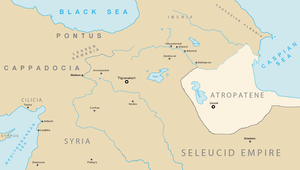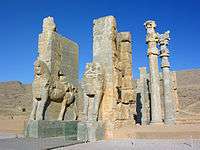Atropatene
| Atropatene | ||||||||||
| ||||||||||
 Map of Media Atropatene and neighboring countries in 1st century BC | ||||||||||
| Capital | Ganzak | |||||||||
| Government | Monarchy | |||||||||
| Historical era | Antiquity | |||||||||
| • | Established | c. 323 BC | ||||||||
| • | Disestablished | 3rd century AD | ||||||||
| ||||||||||
| Today part of | | |||||||||
Atropatene (Greek: Ἀτροπατηνή; originally known as "Atropatkan" and "Atorpatkan" ) was an ancient kingdom established and ruled under local ethnic Iranian dynasties first with Darius III of Persia and later Alexander the Great of Macedonia[1] starting in the 4th century BC and includes the territory of modern-day Iranian Azerbaijan,[2] Iranian Kurdistan,[3] and a small part of the contemporary Azerbaijan Republic. Its capital was Ganzak. Atropatene also was the nominal ancestor of the name Azerbaijan.[4]
History
Following the death of Alexander the Great in 323 BC, the Macedonian's conquests were divided amongst the diadochi at the Partition of Babylon. The former Achaemenid satrapy of Media was divided into two states: The greater (southern) part — Media Magna was assigned to Peithon, one of Alexander's bodyguards. The smaller (northern) region, which had been the sub-satrapy of Matiene, became Media Atropatene under Atropates, the former Achaemenid governor of all Media, who had by then become father-in-law of Perdiccas, regent of Alexander's designated successor.
Shortly thereafter, Atropates refused to pay allegiance to Seleucus, and made Media Atropatene an independent kingdom. It subsequently lost the Media prefix in the name and came to be known simply as Atropatene. The dynasty Atropates founded would rule the kingdom for several centuries, first independently, then as vassals of the Arsacids (who called it 'Aturpatakan'). It was eventually annexed by the Arsacids, who then lost it to the Sassanids, who again called it 'Aturpatakan'. At some time between 639 and 643 the Arabs under the Rashidun took control of the area during the reign of Umar. Atropatene formed a separate province of the early Islamic caliphate and was considered to have had strategic importance. It was during the Arab period that Middle Iranian (i.e. Parthian and Middle Persian) Aturpatakan became Adarbaygan, Adarbayjan or Azerbaijan.
List of rulers
Although the below list is incomplete, they are the known ruling Kings of Media Atropatene.
- Atropates from 320s BC til an unknown date
- Artabazanes (flourished 3rd century BC) ruled in 221 BC or 220 BC, a contemporary of the Seleucid Greek King Antiochus III the Great. He is said to be a paternal grandson of the Persian King Darius II from his marriage to the daughter of Gobryas[5][6][7]
- Mithridates (100 BC – 66 BC), ruled from 67 BC to c. 66 BC who was a son-in-law of the Armenian King Tigranes the Great[8]
- Darius I (c. 85 BC – c. 65 BC), ruled c. 65 BC[9]
- Ariobarzanes I (c. 85 BC – 56 BC), ruled from 65 BC to 56 BC
- Artavasdes I (65 BC – 20 BC), ruled from 56 BC until 31 BC. Son of the above named Ariobarzanes[10] and a son-in-law of King Antiochus I Theos of Commagene[11]
- Asinnalus (flourished 1st century BC), ruled from 30 BC to an unknown date in the 20s BC
- Ariobarzanes II (40 BC – 4), ruled sometime from 28 BC to 20 BC until 4 AD[12] and served as King of Armenia from 2 BC to 4[12]
- Artavasdes II, who served as Artavasdes III (20 BC – 6), King of Media Atropatene and Armenia from 4 AD to 6 AD[12]
- Artabanus (flourished second half of 1st century BC – 38 AD), grandson of Artavasdes I,[11] ruled from 6 until 10
- Vonones (flourished second half of 1st century BC – 51 AD), brother of Artabanus and ruled from 11? until 51[11]
- Pacorus (flourished 1st century & first half of 2nd century), son of the above named and ruled from 51 AD until 78 AD
References
- ↑ Susan M. Sherwin-White, Amélie Kuhrt, "From Samarkhand to Sardis: a new approach to the Seleucid Empire", University of California Press, 1993. pg 78:"The independence of the area Media Atropatene, named after Atropates, satrap of Media under Darius and Alexander (now Azerbaijan), under local Iranian dynasts, was pre-Selecuid"
- ↑ Benson, Douglas S. (1995), Ancient Egypt's warfare: a survey of armed conflict in the chronology of ancient Egypt, 1600 BC-30 BC, D. S. Benson
- ↑ Media Atropatene, Compiled by S.E. Kroll, 1994 in Barrington Atlas of the Greek and Roman World: Map-by-map Directory, Richard J. A. Talbert, Princeton University Press, 2000. Volume 2. pg 1292: "The map approximates the region called by Greek authors Media Atropatene after Atropates, the satrap of Alexander who governed there and later became an independent ruler. The modern name Azerbaijan derives from Atropatene. Originally, Media Atropatene was the northern part of greater Media. To the north, it was separated from Armenia by the River Araxes. To the east, it extended as far as the mountains along the Caspian Sea, and to the west as far as Lake Urmia (ancient Matiane Limne) and the mountains of present-day Kurdistan. The River Amardos may have been the southern border.". pg 1293: "Another important site (but not as large as the places just noted) is the famous fire-temple Adur Gushnasp, situated high in the Kurdish mountains at the holy lake of Takht-i Suleiman, and never mentioned by any ancient western source. It"
- ↑ Yarshater, Ehsan (1983), The Cambridge history of Iran, Cambridge University Press, p. 1408, ISBN 978-0-521-20092-9,
Atropatene see Azarbaijan
- ↑ ARTABAZANES, Encyclopedia Iranica
- ↑ García Sánchez, M (2005): "La figura del sucesor del Gran Rey en la Persia Aqueménida", in V. Troncoso (ed.), Anejos Gerión 9, La figura del sucesor en las monarquías de época helenística.
- ↑ Hallock, R (1985): "The evidence of the Persepolis Tablets", en I Gershevitch (ed.) The Cambridge History of Iran v. 2, p. 591.
- ↑ Cassius Dio, 36.14
- ↑ Azerbaijan iii. Pre-Islamic History, Atropates, Persian satrap of Media, made himself independent in 321 B.C. Thereafter Greek and Latin writers named the territory as Media Atropatene or, less frequently, Media Minor: Parthian period
- ↑ Ptolemaic Genealogy: Tryphaena, Footnote 13
- 1 2 3 Ptolemaic Genealogy: Affiliated Lines, Descendant Lines Archived July 16, 2011, at the Wayback Machine.
- 1 2 3 Swan, P.M. (2004), The Augustan Succession: An Historical Commentary on Cassius Dio's Roman History, Books 55-56 (9 B.C.-A.D. 14), p.114, Oxford University Press
Sources
- Играр Алиев. Очерк Истории Атропатены (Азернешр, 1989) ISBN 5-552-00480-9
- Chaumont, M. L. (1989), "Atropates", Encyclopaedia Iranica, 3.1, London: Routledge & Kegan Paul
- de Planhol, X. (1989), "Azerbaijan I: Geography", Encyclopaedia Iranica, 3.1, London: Routledge & Kegan Paul
- Schippmann, K. (1989), "Azerbaijan III: Pre-Islamic History", Encyclopaedia Iranica, 3.1, London: Routledge & Kegan Paul
- Bosworth, C.E. (1989), "Azerbaijan IV: Islamic History to 1941", Encyclopaedia Iranica, 3.1, London: Routledge & Kegan Paul
Coordinates: 37°N 48°E / 37°N 48°E

